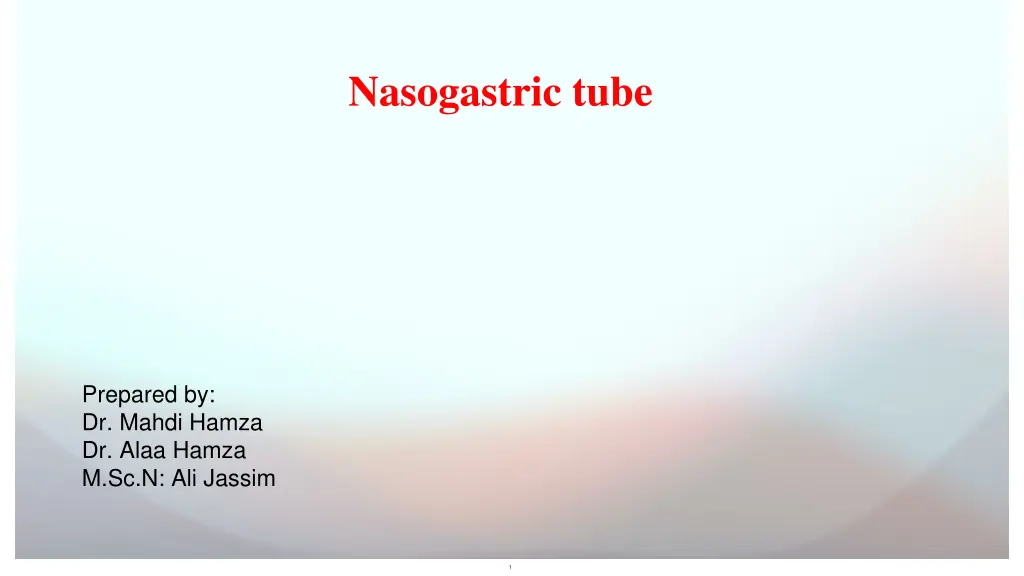
Nasogastric Tube: Definition, Indications, Contraindications & Insertion Procedure
Learn about nasogastric tubes, including their definition, indications (feeding, medication administration), contraindications (facial trauma, coagulopathy), and insertion procedure with step-by-step guidance.
Download Presentation

Please find below an Image/Link to download the presentation.
The content on the website is provided AS IS for your information and personal use only. It may not be sold, licensed, or shared on other websites without obtaining consent from the author. If you encounter any issues during the download, it is possible that the publisher has removed the file from their server.
You are allowed to download the files provided on this website for personal or commercial use, subject to the condition that they are used lawfully. All files are the property of their respective owners.
The content on the website is provided AS IS for your information and personal use only. It may not be sold, licensed, or shared on other websites without obtaining consent from the author.
E N D
Presentation Transcript
Nasogastric tube Prepared by: Dr. Mahdi Hamza Dr. Alaa Hamza M.Sc.N: Ali Jassim 1
Introduction to Nasogastric Tubes: Definition: A nasogastric tube is a flexible tube inserted through the nostril, down the esophagus, and into the stomach. It can be used for feeding, medication administration, gastric decompression, or removing stomach contents. These terms describe the specific purpose and process of using a nasogastric (NG) tube in medical practice:- 1- Gavage: The process of administration nutrition, fluids, or medications directly into the stomach or small intestine via a tube. 2- Lavage: The process of flushing out the stomach contents using fluids, typically through an NG or orogastric tube. 2
Indications: Feeding (for patients unable to swallow) Administration of medications Gastric decompression (removal of stomach contents in cases of obstruction or after surgery) Monitoring gastric bleeding Sampling gastric contents for analysis 3
Contraindications: Facial trauma or skull fractures Severe coagulopathy (risk of bleeding) Esophageal varices 4
Procedure for Nasogastric Tube Insertion Preparation: Verify physician's order. Gather supplies: NG tube, water-soluble lubricant, gloves, tape, syringe (typically 50 ml), stethoscope, water (for the patient to sip if conscious), pH testing strips, and suction setup (if needed). Educate the patient on the procedure to alleviate anxiety and gain cooperation. Wash hands and apply gloves 5
Assessment: Check the patient's level of consciousness and ability to cooperate. Assess the patency of both nostrils (ask patient to breathe through each nostril one at a time). Measure the length of the tube: from the tip of the nose, around the ear, and down to the xiphoid process (the lower end of the sternum). Mark this point on the tube with tape or a marker. 6
Insertion: Position the patient in a high Fowler s position (sitting upright). Lubricate the first 2-4 inches of the tube with water-soluble lubricant. Insert the tube gently into one nostril, directing it toward the back of the throat. As the tube reaches the oropharynx (throat area), encourage the patient to swallow sips of water if they are able. This facilitates the passage of the tube into the esophagus rather than the airway. Continue to advance the tube while the patient swallows, until the mark on the tube reaches the nostril. 7
Verification of Tube Placement: Auscultation: Inject a small amount of air (about 20-30 ml) into the tube using a syringe and listen over the stomach area with a stethoscope. You should hear a "whooshing" sound if the tube is in the stomach. Aspiration: Draw back gastric contents with a syringe and check the pH of the contents. Gastric fluid typically has a pH of 4 or below. X-ray confirmation: This is the most accurate method and is required before using the tube for feeding or medication. Securing the Tube: Secure the tube with tape or a commercial tube fixation device to the nose. Ensure the tube is not kinked or obstructed. 8
Post-procedure Care: Monitor the patient for any signs of distress, coughing, gagging, or cyanosis (which could indicate improper tube placement). Keep the patient in a semi-Fowler's or high Fowler's position to reduce the risk of aspiration. Document the procedure, including tube size, verification method, patient's tolerance, and any complications. Complications: Misplacement: The tube could be misplaced into the airway, leading to potential respiratory complications. Aspiration pneumonia: This occurs if stomach contents are aspirated into the lungs. 9
Key Considerations: Prepare for Emotional Reactions: Be prepared to handle various emotions, including anger, denial, or profound sadness. Offering reassurance that the patient will not beNasal erosion or pressure sores from prolonged tube placement. Gastric irritation or bleeding due to prolonged presence of the tube. Removal of the Nasogastric Tube: Verify the physician's order for removal. Explain the procedure to the patient. Position the patient in a semi-Fowler s position. Flush the tube with air to clear it of contents. Instruct the patient to take a deep breath and hold it (this closes the airway). 10
Quickly and smoothly remove the tube while the patient holds their breath. Inspect the tube for intactness. Provide oral and nasal care after removal. Allow Time for Questions: Patients and families may need time to absorb the news. Let them ask questions at their own pace, and be available to clarify any confusion. 11






















